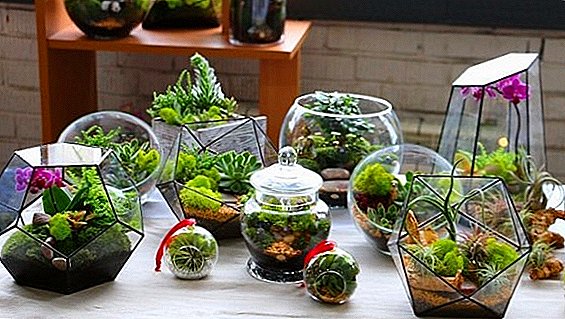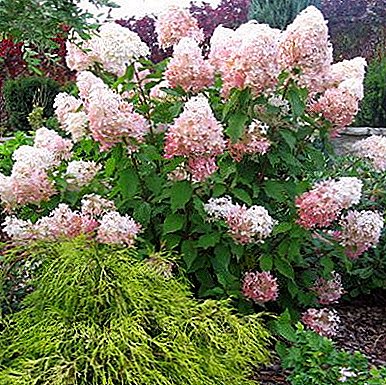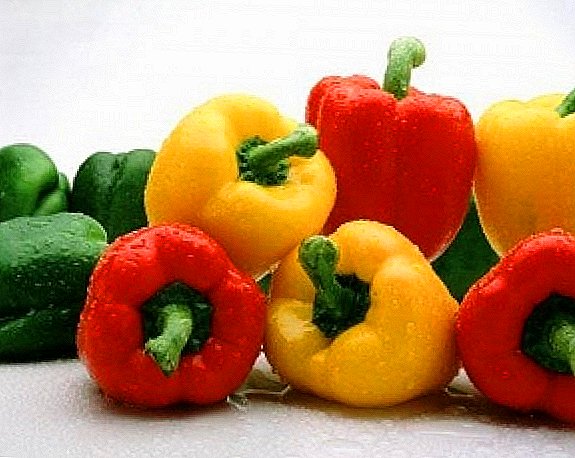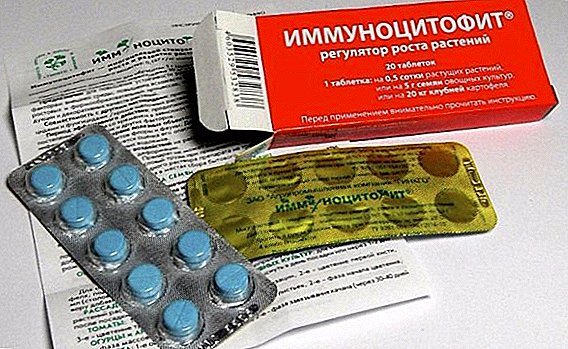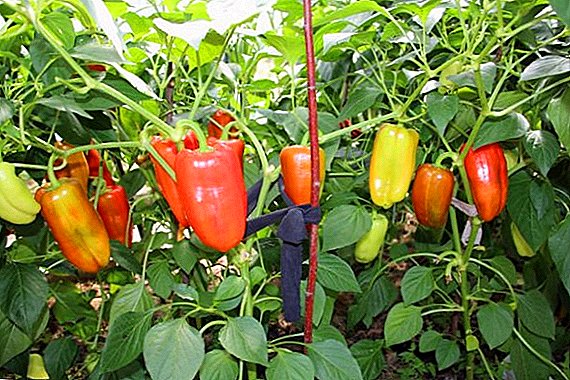 It is unlikely that there will be a private plot on which such a culture as sweet pepper would not be grown.
It is unlikely that there will be a private plot on which such a culture as sweet pepper would not be grown.
Hybrid Gipsey F1 hybrid pepper is very popular due to its disease resistance and good presentation.
Characteristic varieties Gypsy F1
The fruits of "Gypsy" are relatively small in size (weight 100-200 g), belong to the Hungarian type (conical), have fleshy walls. The flesh is juicy, sweetish and aromatic. In the process of ripening, the color of the fruit changes from light yellow to bright red.
Sweet peppers are recommended to be planted next to beans, beans, peas, onions, garlic, on the north side it is best to plant corn.Pepper varieties "Gypsy" is characterized by early ripening and high yield. The bush is about 45-55 cm high, but the stem is rather thin, therefore, the garter is obligatory to the support. Plants are grown both in greenhouses and in the open field. Variety bred in the Netherlands.

Did you know? Homeland pepper - America. Bulgarian it is called only in the post-Soviet countries due to the fact that during Soviet times the main supplier of pepper on its territory was just Bulgaria.
What is needed for growing (conditions)
In general, the variety "Gypsy" is unpretentious, but to increase the yield it is advisable to meet certain conditions.
Pepper loves warm soil, and if you want to get a rich harvest, it is recommended to make beds in the form of mounds about 50 cm high. Also, in view of the low leafiness, some shading of the bushes during the growing season will be useful to avoid burning out the fruits in the sun.
Planting a plant
Planting seeds on seedlings produced in the period from mid-February to mid-March. This seedlings are planted in greenhouses in late May. Seeds for seedlings for open ground sow a couple of weeks later, and the seedlings are planted by mid-June.
Do not plant peppers next to potatoes, tomatoes, eggplants.
Seed preparation
Before sowing, seeds are soaked in a weak solution of potassium permanganate. Floated seeds are discarded. The remaining seeds are washed under running water, dried and sown in the ground.
Substrate Requirements
Sort "Gypsy F1" does not require special substrates, and for it, as well as for its other counterparts, sandy or loamy soil with the presence of lumps and humus is suitable.
Important! Pepper does not tolerate excess nitrogen in the soil.For early varieties, which is the "Gypsy F1", it is not recommended weakly acidic soil - this leads to a reduction in yield. Slaked lime or chalk is added to the soil with increased acidity.
Sowing pepper
A container with seeds sown in the substrate is covered with a film or glass and placed in a warm place (the desired temperature is about 25 °). Seeds germinate within 7-10 days.
How to care for seedlings
After leafing the leaves, the temperature is lowered to 12-16 ° C, depending on the time of day (higher in the daytime, lower at night). Care must be taken to keep the soil moist. Seedlings dive when they grow two full leaves.
In the period of growth of seedlings need to make a few supplements. The first time fertilizer is applied about a week after the pick. The second feeding is carried out at 10-12 days after the first. The third dressing is made several days before transplanting seedlings into the ground or into the greenhouse.
Important! It is better not to replant the seedlings once more, but to pick up such containers in which it can remain until planting in open ground.
Planting seedlings in open ground
Planting seedlings should be carried out carefully, because the shoots are very fragile and fragile, they are quite easy to damage. Before planting fertilizer in fertilizer wells: it is better if it is humus. Plants are planted in one row at a distance of about 35 cm from each other, between the rows leave space up to half a meter.
Basic rules for growing crops
Pepper variety "Gypsy F1" is a fairly unpretentious culture. Nevertheless, we suggest to get acquainted with some recommendations for growing.
It is best to plant sweet peppers after legumes, sideratov, early white and cauliflower, cucumbers, zucchini, squash.
Soil care and weeding
For the bush to grow faster, it is necessary to timely loosen the soil, weed weeding and hilling.
Watering and feeding
After transplantation into the ground, the plant usually "gets sick", this period lasts about a week, after the bush must be fed.
You can buy special fertilizers for peppers, or use the following recipe: Pour several types of cut grass and insist for a week. The bushes are watered with the fermented solution, having previously diluted with water on the basis of proportions 1:10.
Important! Fertilizer is recommended to be applied every 7 days.Pepper needs abundant, but not frequent watering. During the period of fruiting increase the frequency of watering and fertilizing.
Pepper Pegging or Peg
As mentioned earlier, this variety, although it has a relatively small height of the bush, but at the same time a rather weak stem. For these reasons, a garter with pegs or trellis is recommended.
The advantages of the variety
The benefits include:
- the dense thin skin with a easy wax raid provides resistance to storage and transportation;
- super early maturation - 2 months after transplanting to the ground;
Did you know? Sweet pepper contains vitamins of groups A, B and R. According to the content of vitamin C, it is ahead of black currants and lemon.
- excellent taste and conservation preservation;
- unpretentious, has a high yield and disease resistance.


